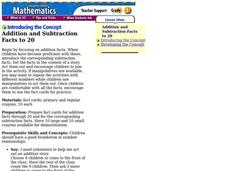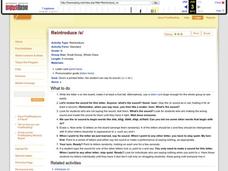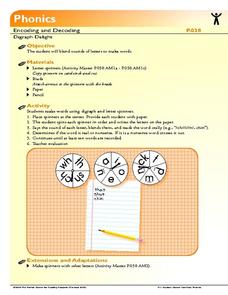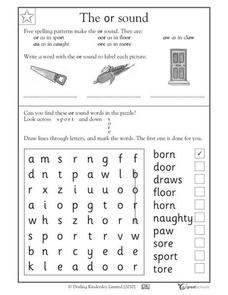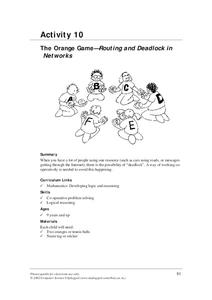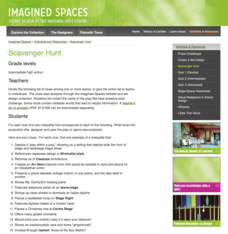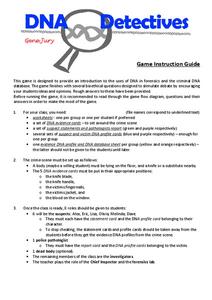Florida Center for Reading Research
Phonological Awareness: Phoneme Matching, Sound Pie
Develop phonological awareness by challenging pupils to recognize final sounds in familiar words. Using magazines or other print resources, scholars search for pictures of words with the same final sound as a starter picture. Once they...
EngageNY
Exploring the Symmetry in Graphs of Quadratic Functions
Math is all about finding solutions and connections you didn't expect! Young mathematicians often first discover nonlinear patterns when graphing quadratic functions. The instructional activity begins with the vocabulary of a quadratic...
Curated OER
Using the Sounds of Words Reading Task
Young readers demonstrate phonemic awareness in words and blends, and recognize 100 high-frequency words. Use a nursery rhyme to point out rhyming words, and change the words by putting a new letter at the beginning. Each learner will...
Houghton Mifflin Harcourt
Addition and Subtraction Facts to 20
First graders act out number stories from number cards. In order to learn about addition and subtraction up to 20 instructional activity, learners become the manipulatives and line up to show the number stories.
Curated OER
Phoneme Blending Accuracy (Mico Version)
Which word is Mico trying to say? A puppet helps make phoneme blending fun as you challenge your scholars to blend segmented words. Mico (or a puppet of your choice) has trouble saying words without separating the phonemes. Using the...
Curated OER
Phoneme Identification with Sound-it-Out Chips
Looking for a tangible way to help emerging readers identify phonemes? You've found it! They use chips without letters to segment single-syllable words into first, middle, and last sounds. As you say each sound, scholars place a chip on...
EngageNY
Triangle Congruency Proofs (part 2)
Looking to challenge your students that have mastered basic triangle congruence proofs? A collection of proofs employ previously learned definitions, theorems, and properties. Pupils draw on their past experiences with proofs to...
Curated OER
Introduce /o/
The best way to get your scholars familiar with the alphabet is to expose them to each letter in multiple contexts. This strategy incorporates letter recognition, sound, word examples, and pronunciation, and emerging readers will feel...
Curated OER
Reintroduce /s/
What letter is this? As you introduce pre-readers to letter sounds, keep them entertained with this fun game. Start by drawing the letter s on the board, large enough for all to see. Once you've demonstrated the sound it makes, use...
Curated OER
Reintroduce /f/
Draw a large letter f on the board to begin this letter recognition and sounds activity, asking kids to identify it if they can. Demonstrate the /fff/ sound and explain how you are making it as learners try it out. What words can...
Curated OER
Reintroduce /e/
These inventive strategies help emerging readers focus on the letter e, forming sound associations along with letter recognition. Explain the mouth movement in making the /eee/ sound, asking learners to try it. Can they think of words...
Curated OER
Further Investigating Greater Than, Less Than, and Equal to
Students investigate number relationships such as greater than, less than, and equal to. In this number relationship lesson, students use number mats and a fish with a large, open mouth to practice showing number relationships.
Florida Center for Reading Research
Phonological Awareness: Phoneme Segmenting, The Sound Game
Pre-readers get a better understanding of phoneme segmenting and counting by playing a board game. They pick an image card from the stack, say the name of the object, break the word down into segments, then move their piece that number...
Florida Center for Reading Research
Phonics: Encoding and Decoding, Digraph Delight
There are three spinners to use in this phonic activity. Spinner one contains digraphs, spinner two contains vowels, and spinner three contains consonants. Learners spin each spinner, write down the letters they get, blend them to make a...
Curated OER
The or Sound
Before using this vowel sounds crossword activity, be forewarned that the pronunciation here is based on British English, and will be confusing for American English speakers. Learners focus on the /or/ sound, examining five spelling...
Computer Science Unplugged
The Orange Game–Routing and Deadlock in Networks
How is data able to move in a congested network? Groups simulate moving data around a congested network by passing fruit around a circle, following specific rules, until everyone ends up with their own fruit. Extension activities...
Virginia Department of Education
Pythagorean Theorem
Investigate the meaning of the Pythagorean Theorem through modeling. After comparing the area of the square of each side, individuals cut triangles and squares to facilitate the comparison.
Curated OER
Missing Letters
As your youngsters begin learning to read, use visual worksheets like this to help them tie objects to words. Scholars examine six images labeled with a word. Each word is missing a first letter, and they must use one of the letters at...
EngageNY
Contrasting Two Settings (Chapter 6: "Lost Melones/Cantalouples")
Continue working through Esperanza Rising, by Pam Munoz Ryan, by looking into language choices and discussing text-dependent questions. Pupils converse in small groups and as a class about plot, setting, and figurative language. Using...
National Security Agency
Time After Time
Save those precious minutes and hours spent planning math lessons with this mini-unit on telling time. Offering a series of engaging hands-on and collaborative learning activities, these three lessons teach children how to read...
Illustrative Mathematics
Transforming the Graph of a Function
Function notation is like a code waiting to be cracked. Learners take the graph of an unknown equation and manipulate it based on three different transformation changes of the function equation. The final step is to look at three points...
American Press Institute
In the Newsroom: The Fairness Formula
Reporting the news is easy, right? Think again! Show young scholars the difficult choices journalists make every day through a lesson that includes reading, writing, and discussion elements. Individuals compare the language and sources...
National Arts Centre
Scavenger Hunt
Young theatre artists engage in a scavenger hunt to acquaint themselves with set design. The challenge is to search the site and match a separate maquette with each of the 24 clues.
Gene Jury
DNA Detectives
Police find a man murdered in a local hotel, DNA everywhere, and now they need scholars' help. Budding detectives step into a crime scene playing the roles of victim, suspects, and investigators. They apply knowledge of criminology and...





